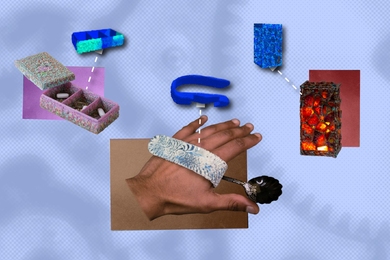Toxoplasma gondii, a parasite that infects about one-third of the world’s population, comes in several strains. Some can have severe consequences such as encephalitis, while others produce no noticeable symptoms.
Jeroen Saeij, an MIT biologist who has been studying Toxoplasma for several years, is trying to figure out the root of that discrepancy. In his latest work, he found that two of the three most common strains of Toxoplasma produce a protein that actually suppresses inflammation in the infected host — a discovery that could help researchers develop new ways to shut off inflammation in patients infected with the more threatening strains of Toxoplasma, or even in people with other inflammatory diseases such as Crohn’s disease.
“There’s a lot of these inflammatory diseases, and if there’s a general pathway that’s really good at quelling inflammation, there might be [drug] applications,” says Saeij, an assistant professor of biology.
Saeij and his colleagues described the new discovery in the June 15 issue of Cell Host & Microbe. Lead author of the paper is postdoc Kirk Jensen.
Inflammation
Toxoplasma spores, which can infect nearly any warm-blooded animal, are often found in dirt; humans can be infected by eating undercooked meat or unwashed vegetables. The parasite can cause encephalitis in individuals with suppressed immune systems and is also harmful to fetuses whose mothers become infected during pregnancy. Some strains, primarily those found in South America, can lead to blindness.
There are about a dozen major types of strains of Toxoplasma; in North America and Europe, the most common is the type II strain, which is also the one most often isolated from patients with complications from Toxoplasma. In a previous paper, Saeij and colleagues showed that type II produces a form of the protein GRA15 that causes inflammation, an immune reaction that is meant to destroy invaders but can also damage the host’s own tissues if unchecked.
In the new paper, Saeij showed that type II also has a variant form of another protein called ROP16. The researchers found that in types I and III, which are less often found in patients with Toxoplasma symptoms, ROP16 suppresses inflammation in the host. However, the form of ROP16 found in type II has no such effect.
When the researchers inserted type I ROP16 into the type II strain, inflammation was suppressed.
Why opposite results from strains of the same parasite? The researchers believe different forms of the parasite evolved to take advantage of different immune reactions from potential hosts. Toxoplasma wants to provoke some inflammation in the host, because inflammation helps the host survive acute infection. As a consequence, the parasite can form tissue cysts that spread to other victims through carnivorism. However, too much inflammation might kill the host and stop the parasite’s life cycle. By employing different strategies, the parasite can be successful in hosts with varying inflammatory responses.
Jon Boyle, an assistant professor of biological sciences at the University of Pittsburgh who was not involved with this research, agrees with this assessment: “What the paper shows really well is that you have these different strains and even though they are quite similar, each type is adapted to different host environments."
A model for Crohn’s disease
In the new paper, the researchers studied Toxoplasma infection in mice. The resulting inflammation of the mouse intestine strongly resembles the intestinal inflammation seen in Crohn’s disease, which affects about half a million people in the United States.
It is unknown if any of these cases are actually caused by Toxoplasma, but Saeij says some studies have shown a higher incidence of Toxoplasma in Crohn’s patients compared with the general population.
Saeij and Jensen are now trying to figure out how the ROP16 protein exerts its anti-inflammatory effects, which could help identify new approaches to developing anti-inflammatory drugs. However, that will likely require many more years of research, Saeij says.
“In reality, going from a discovery to a drug can take decades,” he says. “You hope that you contribute to something like that, but that’s always a long road.”
Jeroen Saeij, an MIT biologist who has been studying Toxoplasma for several years, is trying to figure out the root of that discrepancy. In his latest work, he found that two of the three most common strains of Toxoplasma produce a protein that actually suppresses inflammation in the infected host — a discovery that could help researchers develop new ways to shut off inflammation in patients infected with the more threatening strains of Toxoplasma, or even in people with other inflammatory diseases such as Crohn’s disease.
“There’s a lot of these inflammatory diseases, and if there’s a general pathway that’s really good at quelling inflammation, there might be [drug] applications,” says Saeij, an assistant professor of biology.
Saeij and his colleagues described the new discovery in the June 15 issue of Cell Host & Microbe. Lead author of the paper is postdoc Kirk Jensen.
Inflammation
Toxoplasma spores, which can infect nearly any warm-blooded animal, are often found in dirt; humans can be infected by eating undercooked meat or unwashed vegetables. The parasite can cause encephalitis in individuals with suppressed immune systems and is also harmful to fetuses whose mothers become infected during pregnancy. Some strains, primarily those found in South America, can lead to blindness.
There are about a dozen major types of strains of Toxoplasma; in North America and Europe, the most common is the type II strain, which is also the one most often isolated from patients with complications from Toxoplasma. In a previous paper, Saeij and colleagues showed that type II produces a form of the protein GRA15 that causes inflammation, an immune reaction that is meant to destroy invaders but can also damage the host’s own tissues if unchecked.
In the new paper, Saeij showed that type II also has a variant form of another protein called ROP16. The researchers found that in types I and III, which are less often found in patients with Toxoplasma symptoms, ROP16 suppresses inflammation in the host. However, the form of ROP16 found in type II has no such effect.
When the researchers inserted type I ROP16 into the type II strain, inflammation was suppressed.
Why opposite results from strains of the same parasite? The researchers believe different forms of the parasite evolved to take advantage of different immune reactions from potential hosts. Toxoplasma wants to provoke some inflammation in the host, because inflammation helps the host survive acute infection. As a consequence, the parasite can form tissue cysts that spread to other victims through carnivorism. However, too much inflammation might kill the host and stop the parasite’s life cycle. By employing different strategies, the parasite can be successful in hosts with varying inflammatory responses.
Jon Boyle, an assistant professor of biological sciences at the University of Pittsburgh who was not involved with this research, agrees with this assessment: “What the paper shows really well is that you have these different strains and even though they are quite similar, each type is adapted to different host environments."
A model for Crohn’s disease
In the new paper, the researchers studied Toxoplasma infection in mice. The resulting inflammation of the mouse intestine strongly resembles the intestinal inflammation seen in Crohn’s disease, which affects about half a million people in the United States.
It is unknown if any of these cases are actually caused by Toxoplasma, but Saeij says some studies have shown a higher incidence of Toxoplasma in Crohn’s patients compared with the general population.
Saeij and Jensen are now trying to figure out how the ROP16 protein exerts its anti-inflammatory effects, which could help identify new approaches to developing anti-inflammatory drugs. However, that will likely require many more years of research, Saeij says.
“In reality, going from a discovery to a drug can take decades,” he says. “You hope that you contribute to something like that, but that’s always a long road.”






